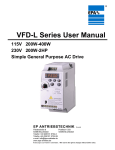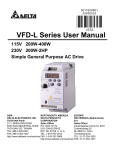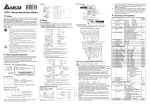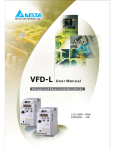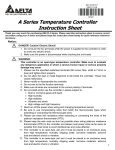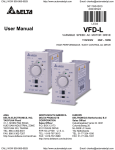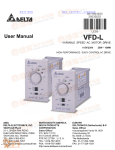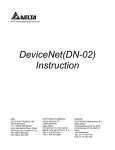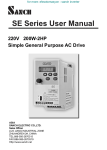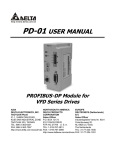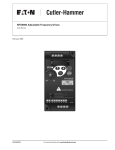Download Delta Electronics VFD-L Series User manual
Transcript
VFD-L Series User Manual 115V 200W-400W 230V 200W-2HP Simple General Purpose AC Drive ASIA NORTH/SOUTH AMERICA EUROPE DELTA ELECTRONICS, INC. DELTA PRODUCTS DELTRONICS (Netherlands) TAOYUAN Plant/ CORPORATION B.V. 31-1, SHIEN PAN ROAD, Sales Office/ Sales Office/ KUEI SAN INDUSTRIAL ZONE P.O. BOX 12173 Industriegebied Venlo Nr. 9031 TAOYUAN 333, TAIWAN 5101 DAVIS DRIVE Columbusweg 20 TEL: 886-3-362-6301 RTP, NC 27709 U. S. A. NL-5928 LC Venlo FAX: 886-3-362-7267 TEL: 1-919-767-3813 The Netherlands http://www.deltaww.com/acdrives FAX: 1-919-767-3969 TEL: 31-77-324-1930 http://www.deltaww.com/acdrives FAX: 31-77-324-1931 Preface Thank you for choosing DELTA’s VFD-L series AC Drive. The VFD-L series is manufactured using high-quality components, material and incorporating the latest microprocessor technology available. This manual will help in the installation, parameter setting, troubleshooting, and daily maintenance of the AC motor drive. To guarantee safe operation of the equipment, read the following safety guidelines before connecting power to the AC motor drive. Keep this operating manual handy and distribute to all users for reference. Important Notes: DANGER! AC input power must be disconnected before any maintenance. Do not connect or disconnect wires while power is applied to the circuit. Only qualified technicians should perform maintenance on the VFD-L. CAUTION! There are highly sensitive MOS components on the printed circuit boards. These components are especially sensitive to static electricity. To avoid damaging these components, do not touch the circuit boards with metal objects or your bare hands. DANGER! A charge may still remain in the DC-link capacitor with hazardous voltages even after the power has been turned off. To avoid personal injury, do not remove the cover of the AC drive until all “DISPLAY LED” lights on the digital keypad are off. Please note that there are live components exposed when the AC drive is open,. Be careful to not touch these live parts. CAUTION! Ground the VFD-L using the ground terminal. The grounding method must comply with the laws of the country where the AC drive is to be installed. DANGER! The AC drive may be destroyed beyond repair if power is misapplied to the input/output terminals. Never connect the AC drive output terminals U/T1, V/T2, W/T3 directly to the AC main circuit power supply. 1 Chapter 1 Receiving and Inspection This VFD-L AC drive has gone through rigorous quality control tests at the factory before shipment. Since many things may happen during shipping, please check for the following after receiving the AC motor drive. ◎ Inspect the unit to insure it was not damaged during shipment. ◎ Make sure that the part number indicated on the nameplate corresponds with the part number of your order. Nameplate Information: Example of 1HP230V AC Drive Model Input Spec. Output Spec. Output Freq. Range Bar Code Serial NO. MODE :VFD007L21A INPUT :1PH/9.7A 3PH/5.1A 200-240V 50-60Hz OUTPUT :3PH 0-240V 4.2A 1.6kVA 1HP Freq. Range:1.0~400Hz 007L21AT101001 DELTA ELECTRONICS, INC. MADE IN XXXXX Model Explanation: VFD 007 L 21 A version A:standard B:including EMI Filter Input voltage VFD-L series Applicable motor capacity 002:0.2kW 004:0.4kW 007:0.75kW 015:1.5kW Variable Frequency Drive Series Number Explanation: T 3 10 001 Production number Production week Production year 2003 Production factory (T: Taoyuan, W: Wujuang) If there is any nameplate information not corresponding to your purchase order or any problem, please contact your distributor. 2 Dimension STOP RUN FWD REV MODE RESET PROG DATA RUN STOP VFD-L MIN. MAX. 0.75KW 230V IPHASE WARNING Do not connect AC power to output terminals (U,V,W). Do not inspect components until LEDs are turned off for at least 1min. Read the user manual before operation. V I RA RC + 10V AVI M0 M1 M2 M3 GND RS-485 3 Chapter 2 Wiring Basic Wiring Diagram Users must connect wiring according to the circuit diagram shown below. Please follow all National and State wiring codes, when wiring the VFD-L. Main Circuit Power MCCB R/L1 U/T1 S/L2 S/L2 V/T2 IM 3~ T/L3 T/L3 W/T3 Motor R/L1 +18V Factory default settings Forward/Stop M0 4.7KΩ Reverse/Stop M1 4.7KΩ Reset M2 4.7KΩ Multi-step 1 M3 4.7KΩ RA Multi-function indication output contacts 120VAC/28VDC 3A RC Factory default: Fault Indication +18V +18V +18V RJ-11 Common Signal GND 6←1 RS-485 Communication port Power supply for Potentiometer +10V 10mA(MAX) +10V Master Freq. setting 3 Analog voltage VR 0〜10VDC VR:3K〜5KΩ 1 Analog current 2 1:+EV 2:GND 3:SG4:SG+ Main circuit (power) terminals AVI Control circuit terminals GND Shielded leads NOTE: Do not plug in a Modem or telephone line to the RS-485 communication port, permanent damage may result. Terminals 1 & 2 are the power source for the optional copy keypad and should not be used while using RS-485 communication. *If the AC Drive model is VFD002L11A/B, VFD004L11A/B, VFD002L21B, VFD004L21B or VFD007L21B, please use power terminals R/L1 and S/L2. *If the AC Drive model is VFD002L21A, VFD004L21A or VFD007L21A, 3 phase power may be used on R/L1, S/L2, T/L3. *If the AC Drive model is VFD015L23A, single phase power is not allowed. 4 Main circuit wiring AC line input terminals grounding Single phase models input from R/L1, S/L2 R/L1 S/L2 T/L3 UP/DOWN LED display Function Display key Data Confirmation key Frequency setting knob RUN/STOP Motor capacity and input power The signal selection for AVI to input DC0~+10V or 4~20 mA RS485 communication port U/T1 V/T2 W/T3 Motor connections U/T1, V/T2, W/T3 Grounding Control circuit wiring Wire Gauge:22-24AWG Torque: 4Kgf-cm RA RC +10V AVI M0 M1 M2 M3 GND Common signal Multi-function input selection 3 Multi-function input selection 2 Multi-function input selection 1 5 Multi-function assistant terminal Analog Voltage, current frequency command Power for speed setting Multi-function indication output contact (120VAC/DC28V 3A) Relay Wiring Notes: PLEASE READ PRIOR TO INSTALLATION. 1. 2. CAUTION: Do not connect the AC input to any of the U/T1, V/T2, W/T3 terminals, as it will damage the AC drive. ! ! WARNING: Ensure all screws are tightened to the proper torque rating. 3. During installation, follow all national and local electrical, construction, and safety codes for the country the drive is to be installed in. 4. Ensure the appropriate protective devices (circuit breaker or fuses) are connected between the power supply and AC drive. 5. Make sure that the leads are connected correctly and the AC drive is properly grounded. (Ground resistance should not exceed 0.1Ω .) 6. Use ground leads that comply with AWG/MCM standards and keep them as short as possible. 7. Multiple VFD-L units can be installed in one location. All the units should be grounded directly to a common ground terminal. The VFD-L ground terminals may also be connected in parallel, as shown in the figure below. Ensure there are no ground loops. Forward running 8. When the AC drive output terminals U/T1, V/T2, and W/T3 are connected to the motor terminals U, V, and W, respectively, the motor will rotate counterclockwise (as viewed from the shaft ends of the motor) when a forward operation command is received. To reverse the direction of motor rotation, switch over any of the two motor leads. 9. Make sure that the power is capable of supplying the correct voltage and required current to the AC drive. 10. Do not attach or remove wiring when power is applied to the AC drive. 11. Do not monitor the signals on the circuit board while the AC drive is in operation. 12. Route the power and control wires separately, or orthogonal to each other. 13. If a filter is required for reducing EMI (Electro-Magnetic Interference), install it as close as possible to AC drive. EMI can also be reduced by lowering the Carrier Frequency. 14. If the AC drive is installed in the place where a load reactor is needed, install the filter close to U/T1, V/T2, W/T3 side of AC drive. Do not use a Capacitor or L-C Filter (Inductance-Capacitance) or R-C Filter (Resistance-Capacitance). 15. When using a GFCI (Ground Fault Circuit Interrupt), select current sensor with minimum current 200mA, and minimum detection time 0.1-second to avoid nuisance tripping. 6 Chapter 3 Summary of Parameters Group 0: User Parameters aThe parameter may be set during operation. Parameters 0-00 0-01 a 0-02 0-03 a 0-04 a 0-05 0-06 0-07 0-08 Functions Settings Factory Setting Identity code of drive (Read only) 1: 40W 2: 100W 3: 200W 4: 400W 5: 750W 6: 1.5KW Rated current display 40W: 0.4A (Read only) 100W: 0.8A 200W: 1.6A 400W: 2.5A 750W: 4.2A 1.5K: 7.0A Parameter reset 10: Reset Parameters to Factory Setting Start-up display of AC 0: F (Frequency command) 1: H (output frequency) drive 2: U (user-defined unit) 3: A (output current) User-defined Unit 0: Display User-Defined Unit (u) 1: Display Counter Value (C) 2: Display Process Operation (1=tt) 3: Display DC-BUS voltage (U) 4: Display output voltage (E) User-defined coefficient K 0.1 ~ 160 Software version Read only Password input 0 ~ 999 Password configuration 0 ~ 999 0 0 0 1.0 #.# 0 0 Group 1: Basic Parameters a a a Parameters Functions 1-00 1-01 1-02 1-03 1-04 1-05 1-06 1-07 1-08 1-09 1-10 1-11 Maximum operation Freq. Maximum setting Freq. Maximum output voltage Mid-point freq. Mid-point voltage Minimum output freq. Minimum output voltage Upper bound of freq. Lower bound of freq. Accel time 1 (Tacc1) Decel time 1 (Tdec1) Accel time 2 Settings 50.0 ~ 400Hz 10.0 ~ 400Hz 2.0 ~ 255V 1.0 ~ 400Hz 2.0 ~ 255V 1.0 ~ 60.0Hz 2.0 ~ 255V 1 ~ 110% 0 ~ 100% 0.1 ~ 600 Sec 0.1 ~ 600 Sec 0.1 ~ 600 Sec 7 Factory Setting 60.0 60.0 220 1.0 12.0 1.0 12.0 100 0.0 10.0 10.0 10.0 Parameters a a a a 1-12 1-13 1-14 1-15 1-16 1-17 1-18 Functions Decel time 2 JOG Accel time JOG Decel time JOG frequency Auto-accel/decel S-curve setting in acceleration S-curve setting in deceleration Settings 0.1 ~ 600 Sec 0.1 ~ 600 Sec 0.0 ~ 600 Sec 1.0Hz~400Hz 0: Linear Accel/Decel 1: Auto accel, linear decel 2: Linear accel, auto decel, 3: Auto Accel/Decel 4: Linear accel. Auto decel, stall prevention during deceleration 5: Auto accel. Auto decel, stall prevention during deceleration Factory Setting 10.0 10.0 10.0 6.0 0 0~7 0 0~7 0 Group 2: Operation Method Parameters Parameters Functions 2-00 Source of frequency command 2-01 Source of operation command Settings 0: Digital keypad 1: 0 ~ 10V from AVI 2: 4 ~ 20mA from AVI 3: Controlled by V.R on drive 4: RS-485 communication interface 0: By digital keypad 1: By external terminals, keypad STOP enable 2: By external terminals, keypad STOP disable 3: By RS-485 communication interface, keypad STOP enable Factory Setting 0 0 4: By RS-485 communication interface, keypad STOP disable 2-02 Stop method 2-03 2-04 Carrier freq. Reverse operation inhibit 2-05 ACI (4 ~ 20mA) input loss detection 0: Decel to 0Hz 1: Stop immediately, display EF 2: Run with the last freq. 0 2-06 Line Start Lockout 0: Enable 1: Disable 0 0: Ramp stop 1: Coast stop 3 ~10K Hz 0: Enable reverse 1: Disable reverse 2: Disable forward 8 0 10 0 Group 3: Output Function Parameters Parameters 3-00 3-01 3-02 3-03 Functions Settings Desired freq. attained 1.0 ~ 400 Hz Terminal count value 0 ~ 999 Preliminary count value 0 ~ 999 Multi-function (relay 0: not used output) 1: AC drive operational 2: Max. Output Freq. Attained 3: Zero Speed 4: Over Torque 5: Base-Block (B.B.) 6: Low Voltage Detection 7: AC Drive Operation Mode 8: Fault Indication 9: Desired Freq. Attained 10: PLC Program Running 11: PLC Program Step Complete 12: PLC Program Complete 13: PLC Program Operation Pause 14: Terminal Count Value Attained 15: Preliminary Count Value Attained 16: Ready State Indicator Factory Setting 1.0 0 0 8 Group 4: Input Function Parameters Parameters a 4-00 a 4-01 a 4-02 4-03 4-04 4-05 4-06 Functions Potentiometer bias freq. Potentiometer bias polarity Potentiometer freq. gain Potentiometer reverse motion enable Multi-function input terminal1 (M1) (d 0〜d 20) Multi-function input terminal 2(M2) Multi-function input terminal 3(M3) (d 0, d 4〜d 20) Settings 0.0〜350Hz 0: positive bias 1: negative bias 1〜200% 0: not used 1: reverse motion enable 2: forward motion only 0: not used 1: M0: FWD/STOP, M1: REV/STOP 2: M0: RUN/STOP, M1: FWD/REV 3: M0, M1, M2: 3-wire operation control mode 4: External fault, normally open (N.O.) 5: External fault, normally closed (N.C.) 6: RESET 7: multi-step speed command 1 8: multi-step speed command 2 9: jog operation 10: accel/decel speed inhibit 11: first or second accel/decel time selection 12: base-block (B.B.),normally open (N.O.) 13: base-block (B.B.),normally closed (N.C) 9 Factory setting 0.0 0 100 0 1 6 7 Parameters 4-06 Functions Multi-function input terminal 3(M3) (d 0, d 4〜d 20) Settings 14: increase master freq. 15: decrease master freq. 16: run PLC program 17: pause PLC 18: counter trigger signal 19: counter reset 20: select ACI/deselect AVI Factory setting 7 Group 5: Multi-step Speed and PLC Parameters Parameters 5-00 5-01 5-02 5-03 5-04 5-05 5-06 5-07 5-08 Functions Settings 1st step speed freq. 2nd step speed freq. 3rd step speed freq. PLC mode 0.0 ~ 400Hz 0.0 ~ 400Hz 0.0 ~ 400Hz 0: Disable PLC operation 1: Execute one program cycle 2: Continuously execute program cycles 3: Execute one program cycle step by step (separate by STOP) 4: Continuously execute one program cycle step by step (separate by STOP) PLC forward/reverse 0 ~ 15 (0: Forward 1: Reverse) motion Time duration step 0 0 ~ 65500 Sec Time duration step 1 0 ~ 65500 Sec Time duration step 2 0 ~ 65500 Sec Time duration step 3 0 ~ 65500 Sec Factory Setting 0.0 0.0 0.0 0 0 0 0 0 0 Group 6: Protection Parameters Parameters 6-00 6-01 6-02 6-03 Functions Over-Voltage Prevention Level Over-current Prevention Level Over-torque detection Over-torque detection level Settings 0:disable 350~410V 0: disable 20~200% 0:disable 1:enable during constant speed operation and continues until the continuous limit is reached. 2:enabled during constant speed operation and halted after detection. 3:enabled during accel and continues before continuous output time limit is reached. 4:enabled during accel and halted after over-torque detection. 30 ~ 200% 10 Factory Setting 390 170 0 150 Parameters 6-04 6-05 6-06 6-07 6-08 6-09 6-10 6-11 6-12 Functions Over-torque detection time Electronic thermal overload relay Electronic thermal characteristic Present fault record Second most recent fault record Third most recent fault record Forth most recent fault record Fifth most recent fault record Sixth most recent fault record Settings 0.1 ~ 10.0 Sec Factory Setting 0.1 0: Not used 1: Act with standard motor 2: Act with special motor 0 30~600 Sec 60 0: No fault occurred 1: oc (over current) 2: ov (over voltage) 3: oH (over heat) 4: oL (over load) 5: oL1 (electronic thermal) 6: EF (external fault) 7: Reserved 8: Reserved 9: ocA (current exceed during acceleration) 10: ocd (current exceed during deceleration) 11: ocn (current exceed during steady state) 0 Group 7: Motor Parameters Parameters Functions a a 7-00 7-01 a 7-02 a 7-03 Motor rated current Motor no-load current Torque compensation Slip compensation Settings 30~120 % 0 ~ 90 % 0 ~ 10 Factory Setting 85 50 1 0.0 ~ 10.0 0.0 Group 8: Special Parameters Parameters 8-00 8-01 8-02 8-03 8-04 Functions DC braking voltage level DC braking time during start-up DC braking time during stopping Start-point for DC braking Momentary power loss Settings 0 ~ 30% Factory Setting 0 0.0 ~ 60.0 Sec 0.0 0.0 ~ 60.0 Sec 0.0 0.0 ~ 400.0 Sec 0: Stop operation after momentary power loss. 1: Continues after momentary power loss, speed search starts with master freq. 2: Continues after momentary power loss, speed search starts with min. output freq. 0.0 0 11 Parameters Functions 8-08 8-09 8-10 8-11 8-12 8-13 8-14 8-15 Max. allowable power loss time B.B. time for speed search Max. speed search current level Skip freq. 1 upper bound Skip freq. 1 lower bound Skip freq. 2 upper bound Skip freq. 2 lower bound Skip freq. 3 upper bound Skip freq. 3 lower bound Auto restart after fault AVR function 8-16 8-17 Dynamic braking voltage DC braking lower bound limit 8-05 8-06 8-07 Settings Factory Setting 0.3 ~ 5.0 Sec 2.0 0.3~5.0 Sec 0.5 30~200% 150 0.0~400 Hz 0.0~400 Hz 0.0~400 Hz 0.0~400 Hz 0.0~400 Hz 0.0~400 Hz 0~10 0: AVR function enable 1: AVR function disable 2: AVR function disable when decel 350 ~ 450V 0.0 ~ 400 Hz 0.0 0.0 0.0 0.0 0.0 0.0 0 2 380 0.0 Group 9: Communication Parameters Parameters Functions a a 9-00 9-01 Communication address Transmission speed a 9-02 Transmission fault treatment a 9-03 a 9-04 Modbus communication watchdog timer Settings 1 ~ 247 0: Baud rate 4800 1: Baud rate 9600 2: Baud rate 19200 0: Warn and continue running 1: Warn and ramp to stop 2: Warn and coasting stop 3: No warn and keep running 0: Disable Factory Setting 1 1 0 0 1~20: 1 ~ 20 Sec Communication protocol ASCII mode RTU mode 12 0: 1: 2: 3: 4: 5: 6: 7: 8: 7,N,2 7,E,1 7,O,1 8,N,2 8,E,1 8,O,1 8,N,2 8,E,1 8,O,1 0 CHAPTER 4 Troubleshooting and Fault Information The VFD-L AC drive has a comprehensive fault diagnostic system that includes several different alarms and fault messages. Once a fault is detected, the corresponding protective functions will be activated. The following faults are displayed on the AC drive digital keypad. The six most recent faults can be read on the digital keypad display by viewing Pr.6-07 to Pr.6-12. NOTE: faults can be cleared by pressing the Reset key on the keypad or Input Terminal. Common Problems and Solutions: Fault Fault Descriptions Corrective Actions Name 1. Check whether the motors horsepower corresponds to the AC drive output power. 2. Check the wiring connections between the AC drive and motor for possible short circuits. 3. Increase the Acceleration time (Pr.1-09, The AC drive detects an abnormal Pr.1-11). increase in current. 4. Check for possible excessive loading conditions at the motor. 5. If there are any abnormal conditions when operating the AC drive after the short-circuit is removed, the drive should be sent back to manufacturer. 1. Check whether the input voltage falls within The AC drive detects that the DC bus the rated AC drive input voltage. voltage has exceeded its maximum 2. Check for possible voltage transients. allowable value. 3. Bus over-voltage may also be caused by motor regeneration. Increase the decel time. 1. Ensure that the ambient temperature falls within the specified temperature range. 2. Make sure that the ventilation holes are not The AC drive temperature sensor obstructed. detects excessive heat. 3. Remove any foreign objects on the heat sink and check for possible dirty heat-sink fins. 4. Provide enough spacing for adequate ventilation. The AC drive detects that the DC bus Check whether the input voltage falls within the voltage has fallen below its minimum rated AC drive’s input voltage. value. 1. Check for possible motor overload. 2. Check electronic thermal overload setting. 3. Increase motor capacity. Internal electronic overload trip 4. Reduce the current level so that the drive output current does not exceed the value set by the Motor Rated Current Pr.7-00. The external terminal EF-GND goes When external terminal EF-GND is closed, the from OFF to ON. output will be turned off. (under N.O.E.F.) Motor overload. Check the 1. Reduce the motor load. parameter settings ( Pr.6-03 to 2. Adjust the over-torque detection setting to an Pr.6-05) appropriate setting. 13 Fault Name Fault Descriptions Over-current during acceleration: 1. Short-circuit at motor output. 2. Torque boost too high. 3. Acceleration time too short. 4. AC drive output capacity is too small. Over-current during deceleration: 1. Short-circuit at motor output. 2. Deceleration time too short. 3. AC drive output capacity is too small. Over-current during steady state operation: 1. Short-circuit at motor output. 2. Sudden increase in motor loading. 3. AC drive output capacity is too small. Corrective Actions 1. Check for possible poor insulation at the output line. 2. Decrease the torque boost setting in Pr.7-02. 3. Increase the acceleration time. 4. Replace with the AC drive with one that has a higher output capacity (next HP size). 1. Check for possible poor insulation at the output line. 2. Increase the deceleration time. 3. Replace with the AC drive with one that has a higher output capacity (next HP size). 1. Check for possible poor insulation at the output line. 2. Check for possible motor stall. 3. Replace with the AC drive with one that has a higher output capacity (next HP size). 1. Switch off power supply. Internal memory IC can not be 2. Check whether the input voltage falls within programmed. the rated AC drive input voltage. 3. Switch the AC drive back on. 1. Check the connections between the main Internal memory IC can not be read. control board and the power board. 2. Reset drive to factory defaults. 1. Switch off power supply. 2. Check whether the input voltage falls within Drive’s internal circuitry abnormal. the rated AC drive input voltage. Switch on the AC drive. Hardware protection failure Return to the factory. Software protection failure Return to the factory. Don’t use the function of auto acceleration/ Auto accel/decel failure deceleration. 1. Check the connection between the AC drive and computer for loose wires. Communication Error 2. Check if the communication protocol is properly set. External Base Block. 1. When the external input terminal (B.B) is AC drive output is turned off. active, the AC drive output will be turned off. 2. Disable this connection and the AC drive will begin to work again. The AC drive detects excessive drive 1. Check whether the motor is overloaded. output current. 2. Reduce torque compensation setting as set in Pr.7-02. 3. Increase the AC drive’s output capacity. 4. Note: The AC drive can withstand up to 150% of the rated current for a maximum of 60 seconds. 14 Standard Specifications Voltage Class 115V 230V 002 004 002 004 007 015 Applicable Motor Output (kW) 0.2 0.4 0.2 0.4 0.7 1.5 0.6 1.0 0.6 1.0 1.6 2.7 1.6 2.5 4.2 7.0 Output Rating Model Number VFD-LA/B Rated Output Capacity (KVA) Rated Output Current (A) Max. Output Voltage (V) 1.6 2.5 3-phase corresponds to double input voltage Three-phase corresponds to input voltage Rated Frequency (Hz) Power Rated Input Current (A) Input voltage Tolerance 1.0~400Hz 6 9 4.9/1.9 Single phase 90~132V 50/60Hz Control Characteristics Operating Characteristics Overload Endurance Accel/Decel Time V/F pattern Stall Prevention Level Keypad Frequency Setting External Signal External Signal Multi-function Input Signal Multi-function Output Signal Other Function Protection Environment Other Cooling 3-phase 180~264V 50/60Hz SVPWM (Sinusoidal Pulse Width Modulation, carried frequency 3kHz~10kHz) 0.1Hz Including the auto-torque, auto-slip compensation, starting torque can be 150% at 5 Hz 150% of rated current for 1 minute 0.1~600Sec. (can be set individually) V/F pattern adjustable 20~200%, setting of Rated Current Setting by ▲▼ keys or V.R Potentiometer-5KΩ/0.5W, DC 0 ~ +10V (input impedance 47KΩ), 4~20mA (output impedance 250Ω), multi-function inputs1 to 3 (3steps, JOG, UP/DOWN command), communication setting Operation Keypad Setting Signal Ì/9 ±5% Output Frequency Resolution Torque Characteristics 9.7/5.1 Single / 3-phase 180~264V 50/60Hz Frequency tolerance Control system 6.5/2.7 Setting by RUN//STOP keys M0,M1,M2,M3 can be combined to offer various modes of operation, RS-485 communication port Multi-step selection 0 to 3, Jog, accel/decel inhibit, first/second accel/decel switch, counter, PLC Operation, external Base Block (NC,NO) selection AC Drive Operating, Frequency Attained, Non-zero speed, Base Block, Fault Indication, Local/Remote indication, PLC Operation indication. AVR, S-curve, Over-Voltage Stall Prevention, DC Braking, Fault Records, Adjustable Carried Frequency, Starting Frequency Setting of DC Braking , Over-Current Stall Prevention, Momentary Power Loss restart, Reverse Inhibition, Frequency Limits, Parameter Lock/Reset Over Voltage, Over Current, Under Voltage, Overload, Electronic thermal, Overheating, Self-testing Including EMI Filter Forced air-cooling Installation Location Altitude 1,000 m or below, keep from corrosive gasses, liquid and dust Ambient Temperature -10℃-40℃ (Non-Condensing and not frozen) Storage Temperature Ambient Humidity Vibration -20℃ to 60℃ Below 90%RH (non-condensing) 9.80665m/s2(1G) less than 20Hz, 5.88m/s2 (0.6Gat) 20 to 50Hz 15
















